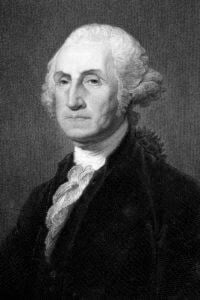
Did George Washington Have Wooden Teeth: We cannot tell a lie— there are a lot of myths and legends celebrating our country’s first president. Even the lovely anecdote about chopping down the cherry tree is of questionable accuracy. One thing is true—18th century dentistry left a lot to be desired. When Washington was president, he had only one natural tooth left and had a set of dentures. These dentures were made of several materials, but wood was not one of them. By taking a look at the fascinating history of dentures, we can appreciate the marvel of modern dental technology.
What were Washington’s teeth made from?
Despite the lack of sophisticated general dentistry, neither Washington nor any others at the time had wooden teeth. Wood was not a practical building material. Dentures at the time were made using a combination of ivory, bone, lead, cow teeth and even human teeth. That may sound bizarre, but it was not unusual at the time for people to buy and sell human teeth. Washington’s teeth were primarily made of ivory. Some historians believe Washington’s fondness for dark wine caused the ivory to heavily stain, giving the impression that the teeth were made of wood. You can even view a picture of them at the Smithsonian website.
Brief history of dentures
As far back as 166 AD, the Etruscans— an ancient civilization in Corsica, Italy–were creating dental gold crowns and bridges as a primitive precursor to dentures. Wooden dentures did exist—they just weren’t worn in Washington’s time. In the 16th century, Japanese craftsmen created wooden dentures that were meticulously carved to match a beeswax impression taken of the patient’s teeth. The first evidence of general dentistry and dentures arose from Frenchman Pierre Fauchard, who wrote a comprehensive book on dental treatment in 1723. It included the first instructions on creating and placing dentures. In 1789, Nicolas Dubois de Chemant of France received the first patent for porcelain teeth. A breakthrough in denture creation arose in 1864 by Charles Goodyear (does that name ring a bell?) Goodyear invented vulcanization, a process that hardens rubber. The resulting material was called vulcanite and could easily be molded into the mouth, creating a more comfortable base for dentures. Vulcanite was affordable and paved the way for future denture development. Today, modern dentures have an acrylic or metal base complemented with acrylic teeth and gum tissue—a far cry from wood, ivory and animal teeth!
Who needs dentures?
Dentures are a good solution for those who have lost several teeth. They do much more than help with eating—they help speech, improve appearance, and support the lips and facial muscles. They also help with speech, appearance and digestive health. Dentures are also a great help for tooth injuries if the emergency has caused several teeth to be knocked out or there was extensive damage.
Common causes of tooth loss include:
- Extensive decay
- Trauma or injury
- Periodontal (gum) disease
- Cracked teeth
There are two main types of dentures.
- A complete denture is a customized, molded mouthpiece that fits the upper and/or lower jaw. These teeth are created to specifically fit comfortably against the gum tissue. They replace all of the teeth.
- A partial denture is used to replace several missing teeth, but not all teeth. They are ideal for patients who may be missing only one type of teeth—such as all the back teeth or all the front teeth.
Your family dentist has the answer
George Washington may not have had much to smile about –at least, when it came to his Perfect Smile Dentures—but today’s dental patient has more options than ever to create comfortable dentures. They can even be adjusted to create the exact shape and shade of the teeth you desire. Your dentist can answer any questions you have and help you evaluate options and even work out a payment plan.
Sources: Academy of Osseointegration. “Common Causes of Tooth Loss.” Online. American Dental Association. “History of Dentistry Timeline.” Online. Moriyama, N., & Hasegawa, M. (1987). “The history of the characteristic Japanese wooden denture”. Bulletin of the History of Dentistry 35 (1): 9–16. Schultz, Colin. Smithsonian Magazine. “George Washington Didn’t Have Wooden Teeth—They were Ivory.” Online.

